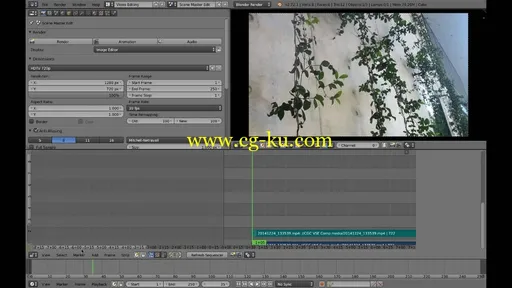
Compositor to VSE
HDRips | MP4/AVC, ~2215 kb/s | 1280x720 | Duration: 00:37:28 | English: AAC, 116 kb/s (2 ch) | 679 MB
Genre: Video
The special effects industry is booming! But it takes a lot of people a lot of time to make a movie. Even short films, like the Blender Foundation’s open movies, take a lot of effort and resources. What if your project is even smaller? What if you just want to treat a shot in your small video differently or perhaps chroma-key out some background to add a new element into the shot?
Is there a quick way to do an effect that isn’t available in Blender’s Video Sequence Editor or VSE? Why can’t we simply send our edited strips to the compositor and trick them up there?
To answer these questions we have to understand Blender’s production flow, or the hierarchy of tools.
At the top sits modelling, sculpting, lighting and animation tools.
When you are done creating objects you need to color them in. So logically following that is material editing and texturing, here we find all the painting tools.
Once you have animated a shot you now have a ‘source scene’. You can render it out as single images, or passes to be combined in the Compositor tool.
Here you can treat the image any way you want and add other images together.
Finally you string out the treated ‘source scenes’ from the compositor, in the VSE so that they play back one after the other.
You can see from this ‘order of tool operation’, that there is no way for media to flow back up hill as it were, from the VSE to the Compositor. Neither can you send media that you create in the compositor back into the 3D view.
No, Blender just expects that you will render all that stuff out first. Not terribly flexible, but very reasonable and sensible to code for.
“Great” I hear you say, “…so how am I supposed to get my shots back into the Compositor?”
The trick is… you don’t. At least it’s not the original strip that you send back up, you import a copy to the compositor and use that back in the VSE. Let’s look at that now. Bear in mind that this workflow only allows you to send one piece of video back to the compositor at a time.
VSE 的排序
HDRips |MP4/AVC,~ 2215 kb/s |1280 x 720 |持续时间: 00:37:28 |英语: AAC,116kb/s (2 ch) |679 MB
体裁: 视频
特殊效果业繁荣起来!但它需要很多人大量的时间来制作一部电影。即使是短小的电影,像搅拌机基础开放电影,花费大量的精力和资源。如果您的项目是更小的?如果你只是想要区别对待一枪在你小的视频或也许色度键出一些背景知识,将新元素添加到镜头吗?
有一个快速的办法,做到在搅拌机的视频序列编辑器或 VSE 中不可用的效果吗?我们为什么不能简单地发送我们编辑的带到排序和欺骗他们,那里吗?
要回答这些问题,我们要理解搅拌器的生产流程或层次结构的工具。
在顶部坐造型、 雕刻,照明和动画的工具。
当您完成您创建对象需要颜色他们。所以从逻辑上,随后是材料编辑和纹理贴图,在这里我们找到所有的绘画工具。
一旦你有动画镜头你现在有一个 '源场景'。你可以呈现出来为单个图像或通过在排序工具相结合。
在这里你可以治疗任何你想要的方式,我们在一起添加其它的图像图像。
最后你串出来处理 '源场景' 从排序,在操作系统 VSE 中,他们打回一个接一个。
你可以看到从这 '顺序的工具操作',是媒体流回了座小山似的,从到排序 VSE 没有办法。您也可以发送回 3D 视图在排序中创建的媒体。
不,搅拌机只是期望你会呈现出第一次所有的东西。不太灵活,但非常合理和明智的代码。
"伟大",我听你说,".......so 怎么回去我拍摄到排序吗?"
把戏...你不要。至少它不是你送回来了,你将一份副本导入到排序和那后面用 VSE 的原始地带。让我们现在看看那。要牢记此工作流只允许您一次向组合器发送视频背部的一次。